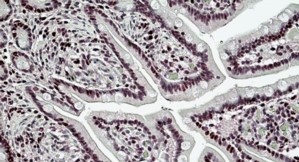anti-BRG1 antibody
ARG54016
ApplicationsImmunoPrecipitation, Western Blot
Product group Antibodies
ReactivityHuman
TargetSMARCA4
Overview
- SupplierArigo Biolaboratories
- Product Nameanti-BRG1 antibody
- Delivery Days Customer23
- ApplicationsImmunoPrecipitation, Western Blot
- CertificationResearch Use Only
- ClonalityMonoclonal
- Concentration1 mg/ml
- ConjugateUnconjugated
- Gene ID6597
- Target nameSMARCA4
- Target descriptionSWI/SNF related BAF chromatin remodeling complex subunit ATPase 4
- Target synonymsBAF190, BAF190A, BRG1, CSS4, MRD16, OTSC12, RTPS2, SNF2, SNF2-beta, SNF2L4, SNF2LB, SWI2, hSNF2b, SWI/SNF-related matrix-associated actin-dependent regulator of chromatin subfamily A member 4, ATP-dependent helicase SMARCA4, BRG1-associated factor 190A, BRM/SWI2-related gene 1, SNF2-like 4, SWI/SNF related, matrix associated, actin dependent regulator of chromatin, subfamily a, member 4, brahma protein-like 1, global transcription activator homologous sequence, homeotic gene regulator, mitotic growth and transcription activator, nuclear protein GRB1, protein BRG-1, protein brahma homolog 1, sucrose nonfermenting-like 4, transcription activator BRG1
- HostMouse
- IsotypeIgG1
- Scientific DescriptionTranscriptional coactivator cooperating with nuclear hormone receptors to potentiate transcriptional activation.Component of the CREST-BRG1 complex,a multiprotein complex that regulates promoter activation by orchestrating a calcium-dependent release of a repressor complex and a recruitment of an activator complex.In resting neurons,transcription of the c-FOS promoter is inhibited by BRG1-dependent recruitment of a phospho-RB1-HDAC repressor complex.Upon calcium influx,RB1 is dephosphorylated by calcineurin,which leads to release of the repressor complex.At the same time,there is increased recruitment of CREBBP to the promoter by a CREST-dependent mechanism,which leads to transcriptional activation.The CREST-BRG1 complex also binds to the NR2B promoter,and activity-dependent induction of NR2B expression involves a release of HDAC1 and recruitment of CREBBP.Belongs to the neural progenitors-specific chromatin remodeling complex (npBAF complex) and the neuron-specific chromatin remodeling complex (nBAF complex).During neural development a switch from a stem/progenitor to a post-mitotic chromatin remodeling mechanism occurs as neurons exit the cell cycle and become committed to their adult state. The transition from proliferating neural stem/progenitor cells to post-mitotic neurons requires a switch in subunit composition of the npBAF and nBAF complexes. As neural progenitors exit mitosis and differentiate into neurons, npBAF complexes which contain ACTL6A/BAF53A and PHF10/BAF45A, are exchanged for homologous alternative ACTL6B/BAF53B and DPF1/BAF45B or DPF3/BAF45C subunits in neuron-specific complexes (nBAF).The npBAF complex is essential for the self-renewal/proliferative capacity of the multipotent neural stem cells.The nBAF complex along with CREST plays a role regulating the activity of genes essential for dendrite growth.SMARCA4/BAF190A may promote neural stem cell self-renewal/proliferation by enhancing Notch-dependent proliferative signals,while concurrently making the neural stem cell insensitive to SHH-dependent differentiating cues By similarity.Also involved in vitamin D-coupled transcription regulation via its association with the WINAC complex,a chromatin-remodeling complex recruited by vitamin D receptor (VDR),which is required for the ligand-bound VDR-mediated transrepression of the CYP27B1 gene.Acts as a corepressor of ZEB1 to regulate E-cadherin transcription and is required for induction of epithelial-mesenchymal transition (EMT) by ZEB1.
- ReactivityHuman
- Storage Instruction-20°C
- UNSPSC12352203





